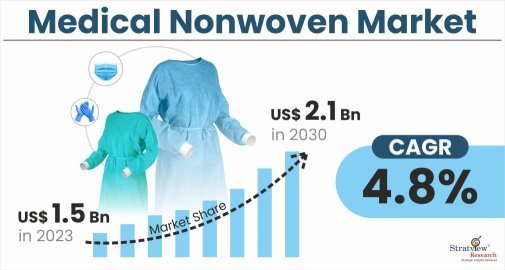The medical nonwoven market has seen remarkable growth in recent years, driven by increasing demand for high-performance, disposable medical products. Nonwoven fabrics are manufactured using fibers bonded together through mechanical, thermal, or chemical means, making them highly suitable for medical applications that require sterility, durability, and cost-efficiency. From surgical masks and gowns to drapes and wound dressings, medical nonwovens have become indispensable in healthcare settings, providing a critical barrier against infection and contamination.
According to Stratview Research, the medical nonwoven market size was estimated at USD 1.5 billion in 2023 and is likely to grow at a decent CAGR of 4.8% during 2024-2030 to reach USD 2.1 billion in 2030.

Key Growth Drivers in the Medical Nonwoven Market
1. Increasing Healthcare Demand: The growing global population, combined with an aging demographic, is one of the primary drivers of the medical nonwoven market. With more individuals requiring healthcare services, the demand for disposable, single-use medical products such as gowns, masks, and sanitary products is surging. Additionally, the rise in chronic diseases and surgical procedures is fueling the need for sterile, high-quality medical nonwovens that can reduce the risk of hospital-acquired infections.
2. Infection Control and Prevention: Infection control remains a critical concern in healthcare, especially in light of the COVID-19 pandemic. The heightened awareness of the need for personal protective equipment (PPE) and infection control measures has significantly increased the demand for nonwoven materials. These materials are crucial in manufacturing products that provide effective microbial barriers, helping to reduce the spread of infections in hospitals and clinics. This has further accelerated the adoption of medical nonwoven products such as N95 masks, face shields, and disposable gowns.
3. Government Regulations and Standards: Stringent regulations and standards set by healthcare organizations and governments are also contributing to the growth of the medical nonwoven market. Regulatory bodies such as the U.S. Food and Drug Administration (FDA) and the European Medicines Agency (EMA) mandate the use of nonwoven fabrics in various medical applications due to their ability to maintain sterility and safety. Compliance with these regulations is driving manufacturers to produce high-quality nonwoven products that meet the specific needs of healthcare institutions.
Emerging Trends Shaping the Industry
1. Sustainability and Eco-Friendly Products: With increasing environmental concerns, there is a growing demand for eco-friendly and sustainable medical nonwovens. Manufacturers are exploring biodegradable and compostable materials to reduce the environmental impact of disposable products. This trend is expected to play a pivotal role in shaping the future of the market, as healthcare providers and consumers alike seek greener alternatives.
2. Technological Advancements: Advances in nonwoven manufacturing technologies are enhancing product quality, efficiency, and functionality. Innovations such as nanotechnology and bio-based materials are leading to the development of more effective, lightweight, and breathable nonwovens. These improvements are creating new opportunities for nonwovens in advanced wound care, filtration systems, and other critical medical applications.
Conclusion
The medical nonwoven market is on a robust growth trajectory, driven by factors such as the increasing demand for infection control products, rising healthcare expenditures, and stringent regulatory standards. As sustainability and technological innovation continue to gain importance, the industry is set to experience further expansion, offering enhanced solutions for the healthcare sector. With these growth drivers and trends in play, the medical nonwoven market is poised to remain a critical component of modern healthcare infrastructure.